
The Mikoyan MiG-29 is a twin-engine jet fighter aircraft designed in the Soviet Union. Developed by the Mikoyan design bureau as an air superiority fighter during the 1970s, the MiG-29, along with the larger Sukhoi Su-27, was developed to counter new U.S. fighters such as the McDonnell Douglas F-15 Eagle and the General Dynamics F-16 Fighting Falcon. The MiG-29 entered service with the Soviet Air Forces in 1982.

The G20 is an international forum for the governments and central bank governors from 19 countries and the European Union. Founded in 1999 with the aim to discuss policy pertaining to the promotion of international financial stability, the G20 has expanded its agenda since 2008 and heads of government or heads of state, as well as finance ministers and foreign ministers, have periodically conferred at summits ever since. It seeks to address issues that go beyond the responsibilities of any one organization.
Augustamnica (Latin) or Augoustamnike (Greek) was a Roman province of Egypt created during the 5th century and was part of the Diocese of Oriens first and then of the Diocese of Egypt, until the Muslim conquest of Egypt in the 640s.
Phacusa was a city in the late Roman province of Augustamnica Prima. It served as a bishopric that was a suffragan of Pelusium, the metropolitan see of that province.

5G is a commonly used term for certain advanced wireless systems. Industry association 3GPP defines any system using "5G NR" software as "5G", a definition that came into general use by late 2018. Others may reserve the term for systems that meet the requirements of the ITU IMT-2020, which represents more nations. 3GPP will submit their 5G NR to the ITU. It follows 2G, 3G and 4G and their respective associated technologies.

Phacusa crawfurdi is a species of moth in the family Zygaenidae. It is found in south-east Asia, including India, Peninsular Malaysia, the Nicobar Islands, Indonesia and the Philippines.
Phacusa manilensis is a moth of the family Zygaenidae. It was described by George Hampson in 1919. It is found on Luzon in the Philippines.
Phacusa nicobarica is a moth of the family Zygaenidae. It was described by George Hampson in 1919. It is found on the Nicobar Islands in the eastern Indian Ocean.
Phacusa paracybele is a moth of the family Zygaenidae. It was described by Alberti in 1954. It is found in China.
Phacusa tonkinensis is a moth of the family Zygaenidae. It was described by Alberti in 1954. It is found in Vietnam.
Phacusa birmana is a moth of the family Zygaenidae. It was described by Oberthür in 1894. It is found in Myanmar.
Phacusa discoidalis is a moth of the family Zygaenidae. It was described by Swinhoe in 1903. It is found in northern Vietnam.
Phacusa dolosa is a moth of the family Zygaenidae. It was described by Francis Walker in 1856. It is found in India and Myanmar.
Phacusa inermis is a moth of the family Zygaenidae. It was described by Alberti in 1954. It is found in China.
Phacusa khasiana is a moth of the family Zygaenidae. It was described by Moore in 1879. It is found in India (Assam).
Phacusa properta is a moth of the family Zygaenidae. It was described by Swinhoe in 1890. It is found in Birma, northern India and the Nicobar Islands.
Phacusa subtilis is a moth of the family Zygaenidae. It was described by Hering in 1925. It is found on Java.
Phacusa tenebrosa is a moth of the family Zygaenidae. It was described by Francis Walker in 1854. It is found in northern India.

Saft el-Hinna is a village and an archaeological site in Egypt. It is located in the modern Al Sharqia Governorate, in the Nile Delta, about 7 km southeast of Zagazig.






